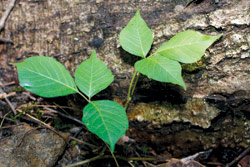I take no chances with poison ivy. Its oil, urushiol, gives me little blisterlike welts that itch for weeks. But by early July, the three-leaved varmint was creeping up the chainlink fence in the dog lot, sneaking into the great swaths of English ivy that cover some corners of my yard, and even assaulting the front of my stone house. Preparing for battle, I donned boots, sweatpants, gloves, a hat and an old, long-sleeved shirt. Then I grabbed the hedge clippers.

My plan had at least one major flaw: It was hot outside, and I was dressed not for comfort but for war. Within minutes, sweat was dribbling into my eyes, yet I dared not wipe away the stinging drops: My gloves were contaminated. So I blinked. A lot.
Meanwhile, I clipped and pulled every three-leaved vine I saw, especially the ones with fuzzy tendrils along reddish roots. As I scrunched behind the big camellia, I slid one clipper blade between stone and root, leveraging to pull the tendrils loose, then pinching the blades almost closed so I could grip the vine without either touching or cutting it.
Into a leaf bag it went — which isn't easy when you're gingerly holding a long, fuzzy vine at arm's length while negotiating the opening. But burning poison ivy is simply not an option: If you inhale any smoke, it could put you in the hospital.
After a few hours' work, the dog's yard was reasonably clear, and I was very thirsty.
Before the next campaign, I swore to seek out more tips from experts and friends.
Earlier this summer, a co-worker suffered a severe rash after battling poison ivy in her yard, despite having worn gloves and boots. She tried all manner of home remedies (even one involving wild plantain and spit, I believe), and she wore loose, flowing skirts to work for more than a week.
I don't do skirts. But what's an environmentally conscious gardener to do?
State agriculture folks and several online resources touted heavy-duty herbicides, which tend to kill everything green. And a 2005 Duke University study merely reported that higher CO2 levels make poison ivy grow bigger and faster — and the urushiol seems to gain potency. In other words, this nasty plant loves global warming.
A fellow writer e-mailed me, remarking, "You'll hate me, but I can literally pull poison ivy up with my [bare] hands and weed it out of my garden. It doesn't bother me at all. No rash, no itching, nothing." She promised to ask her husband what he does, noting, "He runs from it."
I asked a landscaper what she'd do. She scrunched up her face. "That's a tough one. You've got to get the roots," she said. If you're avoiding the use of herbicides, old-fashioned, manual cutting and pulling is the only way, she insisted. Use a weed-eating machine, and you'll spray the noxious debris everywhere — including your face.
Goats devour poison ivy. A local cheese-maker confirmed this, saying there used to be tons of it in her pasture, but the goats have eradicated it. Unfortunately, these nonpicky eaters will also devour just about anything else within reach, so they might not be a good choice for a mature city garden with a complement of prized perennials and bulbs. The cheese-maker also told this cautionary tale: A friend's goats liked to give her kisses on her face. But after they'd devoured some poison ivy, she wound up with a horrible rash on her face and eyes.
Ick!
My dogs don't eat poison ivy, but they do brush up against it when they're out and about. Urushiol can cling to their fur (and it doesn't matter whether the offending plant was alive or dead). So I get new rashes almost every week, even when I'm not actively doing battle.
All in all, it's got me so paranoid I freeze in my tracks when I see anything with three leaves. I'm beginning to understand why some folks just throw in the towel and reach for the herbicides. And I admit that the seductive phrase "Just nuke it!" does come to mind. But I won't. Instead, I'll choose some cool morning, don my battle gear, grab the gloves and clippers, and keep pulling. As The Coasters warned in 1959, "Late at night while you're sleepin', poison ivy comes a creepin' around."
Send your garden news to mvwilliams@mountainx.com, or call 251-1333, ext. 152.
I dared not wipe away the stinging drops: My gloves were contaminated.



I hate to be the bearer of bad news, but if you have a healthy crop of poison ivy you also likely have a healthy crop of poison ivy seed in the soil just waiting to germinate. Birds eat and spread the seed in their droppings so you can never be rid of it totally, particularly if you have a tree they like to roost in a night.
It is difficult to pull the entire vine and root system which can just resprout. After your major removal by force, you just might want to consider some targeted spraying.